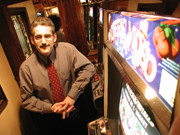
Concordia’s Peter Shizgal (above) collaborated with Princeton’s
Daniel Kahneman, awarded the Nobel Prize in Economic sciences earlier
this month.
File Photo
|
by Mirjana Vrbaski
Concordia’s Peter Shizgal, Director of the Centre for Studies in
Behavioural Neurobiology, rejoiced on Oct. 9, as the Nobel Prize in Economic
Sciences went to a collaborator, Princeton’s Daniel Kahneman.
A study by Shizgal and Kahneman of the brain in the act of gambling bears
the imprint of Kahneman’s groundbreaking contributions to the integration
of psychological research into economics, for which Kahneman has been
rewarded with the world’s most prestigious prize.
Kahneman, a psychology and public affairs professor at Princeton University,
N.J., is especially prized for his work on human judgment and decision-making
under uncertainty. This research is vital to understanding the mental
processes of gamblers, investors, medical diagnosticians and decision-makers
in many realms. The implications of this work are being pursued here at
Concordia by Shizgal and his PhD student, Bonnie Sonnenschein.
“My research, like some aspects of Kahneman’s research, consists
of trying to understand the psychological mechanisms and neural machinery
involved in evaluation and decision-making processes,” Shizgal said
in an interview.
To better grasp the way various parts of the human brain respond to the
anticipation of winning money, Shizgal and Kahneman teamed up with Hans
Breiter, Itzhak Aharon and Anders Dale, of Massachusetts General Hospital,
to bridge psychology and neural science in a brain-imaging experiment.
Twelve volunteers were given $50 and then shown a sequence of spinners
divided into three sectors, each with a different monetary value. A spinning
arrow delivered either a loss or a gain to each participant.
The subjects’ brain activity was measured through a neuro-imaging
process both during anticipation and when they realized, or processed,
the outcome of the spin.
This novel application of the psychology of judgment and decision to mapping
brain function supports the view that common brain circuitry processes
different types of rewards. In other words, a socially conditioned reward,
such as money, produced patterns of brain activity that overlaps those
seen during anticipation or experience of other rewards, such as addictive
drugs, pleasant tastes, or preferred pieces of music.
Such findings may one day enable scientists to use brain scans to measure
the neural correlates of our subjective likes and dislikes. They may also
help understand impulse-control disorders, such as drug abuse and compulsive
gambling.
The design of the brain-imaging experiment reflects a longstanding program
of research on evaluation and decision-making by Kahneman and his colleague,
Amos Tversky, who died in 1996. They described shortcuts people take and
the biases they have in making decisions — results that challenged
the basic model of how individuals behave economically.
Before their work was published, economists tended to portray humans as
engaged in the rational maximization of their self-interest. Kahneman
and Tversky’s work challenges this view, and has played a seminal
role in the development of behavioural economics, a field that seeks to
build a psychologically realistic portrayal of human behaviour in economic
contexts.
“By giving economists different ways of understanding how people
make decisions, psychology has brought in more flexibility into economics
research, which was traditionally much more restricted,” said Ian
Irvine, economics professor at Concordia. “In turn, a more flexible
way of perceiving human behaviour impacts public policy.”
Kahneman’s contributions to economics, together with those of Vernon
Smith, will be officially celebrated Dec. 10 at the glittering Nobel Prize
awards ceremony in Stockholm.
Shizgal continues to study brain mechanisms underlying evaluation and
decision-making, both in laboratory animals and in humans. His work may
have implications for understanding impulse-controlled disorders. For
example, he looks forward to experiments that would compare self-controlled
groups — gamblers who can get up and walk away — to groups with
no such control. However, he warns that, at this stage, we have no assurance
that a cure for compulsive gambling is around the corner.
“Even if we do succeed in developing a good neurological account
of impulse-control disorders, effective treatments are not guaranteed.
However, we may well have a better chance of developing such treatments
if we can understand the processes in the brain that determine impulse
control.”
|
|
|



